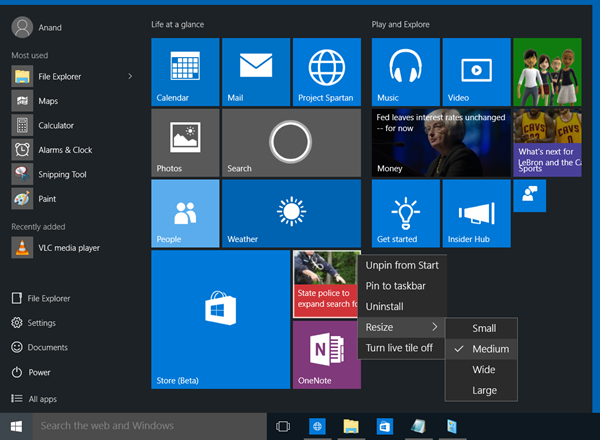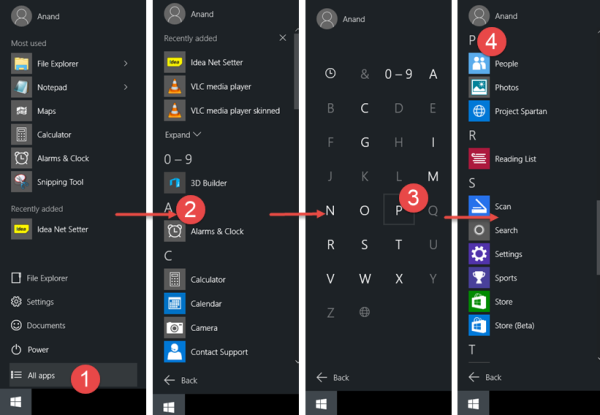Not only is the Start Menu in Windows 10 good to look at, but it is also now supercharged and lets you do a lot more. Let us have a look at some of its features and see how we can personalize our Windows 10 experience, by customizing the Start Menu.
Windows 10 Start Menu Features

As is expected, the Start Menu, or simply Start, gives you access to your User Documents, Oft-used and pinned software and apps, File Explorer and so on. Something notably new here is that the Start now includes Live Tiles too.
You can:
- Remove the frequent items from Start Menu.
- You can disable content suggestions that Microsoft may show at the top of the start menu from time to time; mostly it is related to Windows store apps that Microsoft thinks you will be interested in
- You can remove the New list by turning off Show recently added apps group. This, however, will not prevent All Programs from showing New under the option and once you expand All Programs. The new items will still show New under the item name. The option “Show Recently Added Apps Group” only removes the folder or group that contains a list of newly added apps. The group is useful when you can’t find your programs in All Programs, but when you expand it, you will find it mighty long to get confused among the list it produces
- From the same window, you can opt to Turn Off the list of recently opened items; remember that it is different from recently added as the latter shows a list of recently installed programs and the recently opened items shows a list of documents, spreadsheets, image files, sound or video files. In short, this option lets you see the list of data files, while the option mentioned in number 3 above, shows the list of recently added or installed programs
- Finally, you can get the Start menu to be shown full screen; There is no need for regular users to show the Start menu in full screen but for those who are using tablets and mobile devices.
- Show Color on Start Menu and Taskbar
- Pin any system setting to the Start.
Let us now have a look at the Start Menu and some of its settings in detail.
Live Tiles & Groups
The Start now includes Tiles. You can pin tiles to Start. If the app is programmed to display Live Tiles, you will see Live Tiles in your Start Menu too. You can pin apps, program shortcuts, files, folders and even the Drive to Start. Simply right-click on the item and select Pin to Start. Drag and drop them around, to arrange them in Groups and give the Groups useful names.
The typical context menu for each Tile would include:
- Unpin from Start
- Pin to Taskbar
- Uninstall
- Resize – Small, Medium, Wide, Large
- Turn Live Tile off.
You can move the tiles, resize them and even group them. You can move items from the left side to the right side of Start and display them as Tiles. You can also uninstall apps from the Start itself, using its context menu.
Give it the Classic Windows 7 look
If you wish, you can right-click on each Tile and unpin it to make the Start look compact, giving it the classic look.
Resize Start or make it display full-screen
You can resize the Start Menu by dragging at its right and top edge. You can even display Start Menu in full screen, via Settings > Personalization > Start.
Most used Programs
The Start displays the Most used programs. This gives you easy access to apps and software that you use frequently. But if you wish, you can remove this Most Used list.
Recently added software & apps
If you installed new apps or software, they would get listed here. You can show or hide Recently added apps group.
Content Suggestions
Start will also recommend apps and content to you, which it thinks may interest you. However, you can disable this feature if you find it irritating, via Settings > Personalization > Start.
Quick navigation to apps list

Open Start, click on All apps. Next click on any alphabet – say A. You will see the alphabets displayed. Click on one of them and you will be taken to the apps starting with that alphabet.
Tweak Start Menu Properties
Right-click on the Windows 10 taskbar and select Properties. Under the Start Menu tab, you will see a Customize button. Click on it to open the Customize Start Menu box. Here you will be able to customize how links, icons, and menus look and behave on the Start Menu. You can add system items and disable or enable context menus and the drag-and-drop function. This box offers you a lot of options to customize Start Menu in Windows 10.
Read: Guide to customize Windows 10 Start Menu and Taskbar.
If there is anything else you’d like to add or something I have missed, please do so in the comments section.
Nice post, Anand. We can always depend on you to provide us with useful tips to improve usability.
Thank you, Muliano. :)
Thanks for the post. I see the option to “Turn Live Tile Off” this is great! Can you configure or disable the “Most Used” and “Recently Added” areas of the menu? Also, I don’t see any pinned programs/apps (not live tiles), is that function available? My very first clicks would be to turn off those damnable live tiles but I suppose I could put up with the wonky “All Apps” functionality if I could pin enough to my menu (menu side, not live tiles) that I didn’t have to open it, ever. We might yet survive W8.
Hello fellas! I’ve got a question! No matter how many apps I download at the same time, only one app(the last downloaded) shows up under the ‘Recently Added’. Why not all the apps I’ve recently added? Is it normal how its being shown?
In my windows 10 pro, the “start menu tab” in “Taskbar and start menu properties” is missing…
Thanks for the post – it was helpful. It is still frustrating that the windows 10 start menu does not allow customization of which programs appear on the left. I know the right can be customized but the tiles are less recognizable than the classic icons, plus there doesn’t seem to be quick access to specific program files any more (windows 7 start menu was very convenient to have the custom-placed programs show an arrow which would display that program’s recently used files). Do you know of any way to do this?
See http://forum.thewindowsclub.com/windows-tips-tutorials-articles/36899-start-menu-tab-missing-windows-10-taskbar-properties.html
The best you can do is – you can right-click on each Tile and unpin it to make the Start look compact, giving it the classic look. Also does this help? https://www.thewindowsclub.com/show-hide-recently-added-apps-windows-10-start-menu
Any idea what registry keys control the layouts? Or even what each”view” is called?
The alphabetic listing is probably not best for everyone but I wish I could make it the default for myself. By that, I mean the final 0-9 and A-Z with no other isons allowing me to quickly navigate to the “R” programs. Even better would be an option to pick one by clicking the corresponding letter on the keyboard. I have a feeling this layout is more intended for the “tablet” displays but when you have hundreds of programs on your system and already know what you want, getting there would be so much easier with that type of access